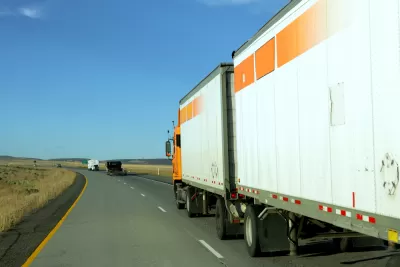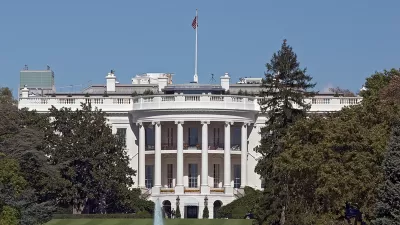The U.S. Environmental Protection Agency and U.S. Department of Transportation jointly issued final standards on Aug. 16 to reduce emissions and improve fuel economy for heavy duty trucks which currently average about six miles per gallon.

"The Obama administration on [Aug. 16] issued aggressive new emissions standards for heavy-duty trucks," reports Bill Vlasic for The New York Times. "The rules are expected to achieve better fuel efficiency and a bigger cut in pollution than the version that was first proposed last year."
Officials said the new standards would require up to a 25 percent reduction in carbon emissions for big tractor-trailers over the next 10 years, and somewhat smaller improvements for delivery trucks, school buses and other large vehicles.
As with regulations on emission standards for passenger vehicles (which include light trucks), the rules are jointly issued by the U.S. Environmental Protection Agency (EPA) and the U.S. Department of Transportation, specifically through the National Highway Traffic Safety Administration. EPA regulates greenhouse gas emissions while NHTSA regulates fuel efficiency, using the term Corporate Average Fuel Economy, or CAFE.
EPA Administrator Gina McCarthy "said the standards were 'ambitious but achievable,' and were decided after hundreds of meetings in the last year with groups representing truck manufacturers, fleet owners and environmental organizations," adds Vlasic. But they will add to the costs of new trucks, though they achieve cost savings too.
Analysts have estimated the cost of complying with the new standards at $12,000 a vehicle. [Transportation Secretary Anthony Foxx] said those investments would be outweighed by larger economic gains such as reduced fuel consumption.
[He] said the trucking industry would save an estimated $170 billion in fuel costs through 2027 and reduce petroleum consumption by two billion barrels over the lifetime of the vehicles sold under the new rules.
The new standards are welcome news for environmentalists. Transportation supplanted power plants last February as the largest source of carbon emissions in the U.S. economy. "Within the transportation sector, heavy-duty vehicles are the fastest-growing contributors to [greenhouse gas] emissions," according to an EPA-NHTSA fact sheet [PDF] on the new standards.
FULL STORY: New Rules Require Heavy-Duty Trucks to Reduce Emissions by 25% Over the Next Decade

Rethinking Redlining
For decades we have blamed 100-year-old maps for the patterns of spatial racial inequity that persist in American cities today. An esteemed researcher says: we’ve got it all wrong.

Planetizen Federal Action Tracker
A weekly monitor of how Trump’s orders and actions are impacting planners and planning in America.

Walmart Announces Nationwide EV Charging Network
The company plans to install electric car chargers at most of its stores by 2030.

New State Study Suggests Homelessness Far Undercounted in New Mexico
An analysis of hospital visit records provided a more accurate count than the annual point-in-time count used by most agencies.

Michigan Bills Would Stiffen Penalties for Deadly Crashes
Proposed state legislation would close a ‘legal gap’ that lets drivers who kill get away with few repercussions.

Report: Bus Ridership Back to 86 Percent of Pre-Covid Levels
Transit ridership around the country was up by 85 percent in all modes in 2024.
Urban Design for Planners 1: Software Tools
This six-course series explores essential urban design concepts using open source software and equips planners with the tools they need to participate fully in the urban design process.
Planning for Universal Design
Learn the tools for implementing Universal Design in planning regulations.
City of Moorpark
City of Tustin
City of Camden Redevelopment Agency
City of Astoria
Transportation Research & Education Center (TREC) at Portland State University
Regional Transportation Commission of Southern Nevada
Toledo-Lucas County Plan Commissions




























